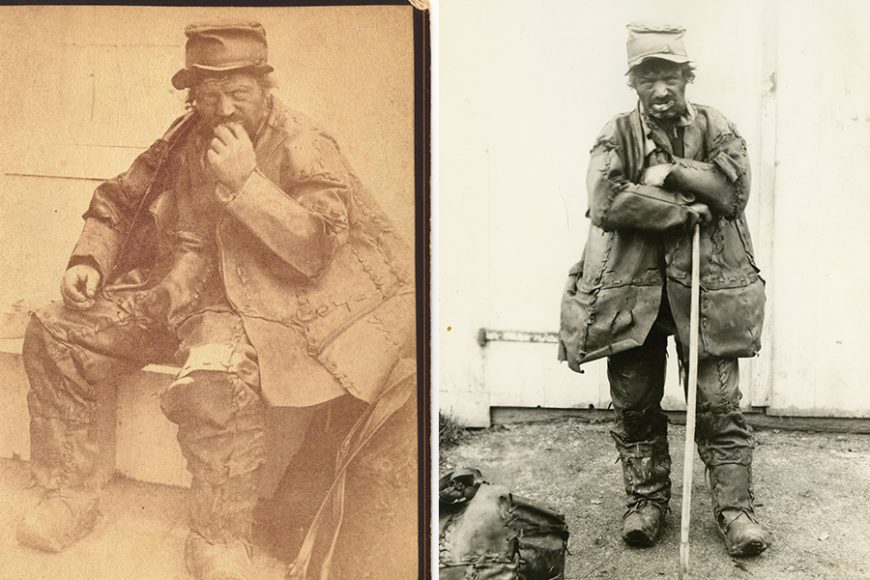During the latter part of the 19th century, a curious vagabond became one of the most famous people in the region stretching between the Hudson and Connecticut rivers. No one ever learned his name — he was merely known as the Old Leatherman, a reference to his ragged hand-stitched clothing — but his strange life intrigued and captivated nearly everyone who came into contact with him.
It isn’t clear when or where the Old Leatherman first appeared — the earliest recorded appearance occurred in Harwinton, Connecticut, in 1858, though he may have been in the region earlier — and he may not have gained much initial notice since it was not unusual for itinerant wanderers to roam the countryside in the pre-Civil War years. But this man clearly stood out in his surroundings. Regardless of the season, he was always dressed in the same coarse leather suit, leather gloves, a battered leather hat and hand-hewn leather and wooden boots. The garments weighed a total of 60 pounds and he carried a large pack that would often weigh just as much.
What the Old Leatherman wore was all the more remarkable when you consider his life: He walked a continuous 365-mile clockwise loop through southwestern Connecticut and into lower Fairfield County, then up Westchester County into the lower Hudson River Valley and back into Connecticut by way of Danbury. From there, he headed east to Watertown, then southeast to Middletown, then west to New Canaan and further back into Westchester. The entire trip zigzagged through 41 towns and was made over a 34-day stretch, which he repeated endlessly until his death in 1889.
During this period, the region was mostly agricultural and the Old Leatherman would rely on the kindness of farmers for food. These were among the relatively few direct interactions between him and the wider society, and once his routine became settled it never changed: He would arrive at a farmhouse that had been hospitable to him and either mime for food or just say “eat.” Without fail, the local townspeople were generous in aiding him, and many even invited him to take shelter in their barns.
But the more that people tried to know the Old Leatherman, the more elusive he became. He was never known to accept the invitation of overnight shelter. Instead he created a network of caves where he took refuge during the night. Attempts to give him money were politely rebuffed, although he gladly accepted cigars and tobacco for his tin pipe. And those who pried him for conversation encountered responses in broken English spoken in a heavy French accent. A French-language prayer book was found in his belongings following his death. Some sources claimed that he carried a rosary and would decline the offer of meat on Fridays, leading to speculation of a Roman Catholic heritage — but there is no record of him ever seeking solace in a church.
The Old Leatherman became such an integral fixture of local life that newspapers began to focus on his peculiar presence. One of the first articles to cover his travels came in an 1870 edition of the Port Chester Journal under the headline “A Strange Character.” The article’s author found his way into one of the Old Leatherman’s caves in Westchester and detailed a world where “several troughs of different lengths and dimensions (were) used as a receptacle for meat, hides, etc. Two were filled to completion with nauseous looking beef, another contained something which is not usually put down on our ‘bill of fare,’ and the largest contained a cow’s hide immersed in ashes and water to remove the hair preparatory to tanning and which, no doubt, is destined to replenish the dilapidated wardrobe of this eccentric individual.”
Another article from that era appeared in the New Haven Evening Register and it portrayed the Old Leatherman taking in a meal provided by a generous farm family. “Slice after slice of bread disappeared,” the article stated, “and huge blocks of meat went after them in rapid succession, and the manner in which he consumed his pie and cake reminded me of an expert magician disposing of his cards.” The Connecticut Valley Advertiser devoted an 1875 article to him, asking its readers, “Where does he come from? And where does he go to? And who is he?”
The Waterbury Daily American insisted that it solved the mystery of the Old Leatherman with an 1884 article by W.A. Sailson that claimed he was a Frenchman called Jules Bourglay who descended into madness due to financial and romantic ruin in his native country. The story was quickly debunked by other journalists who could find no evidence to back Sailson’s wild speculations. Other press stories envisioned the Old Leatherman as the keeper of a vast hidden treasure and a grand underground residence, but those tales produced laughter from those who knew the enigmatic wanderer.
The Old Leatherman might have been aware of his media celebrity status, as he willingly posed for portraits in the local photographic studios. At least 20 pictures of him are known to exist, though it is not clear if he was compensated for his presence before the cameras. At one point, he became so famous that some villages allowed their schools to close early so the students could greet and wave at the Old Leatherman as he walked through their streets. Farm wives were known to bake bread for him ahead of his arrival in their areas. But he was not universally loved. There were some press reports of violence against the Old Leatherman carried out by rock-throwing children and miscreant adults, though there is no record of him attacking people.
When the Blizzard of 1888 hit the region, there was a great fear for the Old Leatherman’s survival. He persevered, but his health was already deteriorating. A growth on his lip became cancerous, and there were reports that he had trouble consuming food and liquid because of this condition. Some communities sought to have him hospitalized and he was briefly detained and transported to Hartford Hospital, but he escaped shortly after arriving. On March 24, 1889, the Old Leatherman’s body was found in his cave in Mount Pleasant. The coroner determined that he had been dead for several days before being found.
In death, the Old Leatherman retained an air of controversy. He was initially buried in an unmarked grave at Sparta Cemetery in Ossining, with a metal pipe as a grave marker. A headstone was placed on the grave in 1953 incorrectly identifying him as Jules Borglay. The grave was moved in 2011, but during the exhumation there was no evidence of a body or a coffin, only some nails — the heavily acidic soil was blamed for the disappearance of his remains. A new headstone marked “The Leatherman” was placed in his honor at the cemetery. This marker still attracts visitors who leave coins and rosaries in honor of the most mysterious man to live in plain sight.





